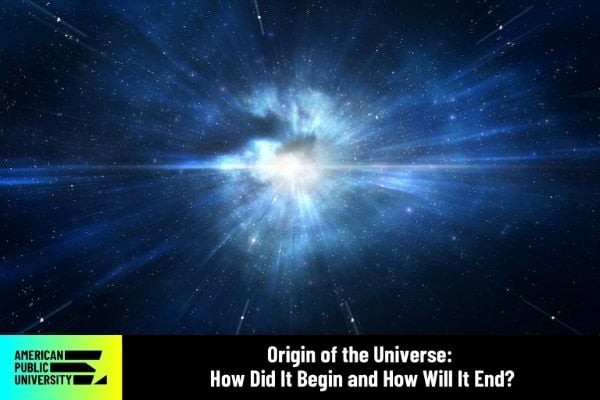By Dr. Gary L. Deel | 05/14/2024

The mysteries surrounding the origin of the universe have captivated our minds for ages, sparking curiosity and contemplation across different eras. Whether through relaying myths, exploring space, or creating modern scientific hypotheses, humanity has sought to unravel the numerous secrets of the cosmos that envelops us.
Cosmology: The Birth of Myths and Tales
Long before scientific exploration took center stage, various civilizations around the world crafted elaborate stories to explain how the universe came into existence. These stories, rich in symbolism and metaphorical significance, provided societies with a narrative framework to comprehend the complexities of their surroundings and their own relevance.
In Egyptian cosmology, people believed that the universe emerged from the primordial waters of the creator god, Nun, and these waters formed an abyss with boundless potential and endless possibilities. The sun god, Atum, was credited with bringing structure and form to the cosmos through his creative prowess.
In a similar vein, ancient Greek cosmogony tells the tale of the primeval god Chaos giving birth to the universe, from where the gods Gaia (Earth), Uranus (Sky), and other primordial deities emerged. These ancient myths don’t coherently explain any of the natural events in our universe, but they do convey cultural stories that mirror societal values, beliefs, and dreams.
The Emergence of Modern Cosmology and the Big Bang Theory
The 20th century marked a change in our comprehension of how the universe began through modern cosmology. In the 1920s, Edwin Hubble’s groundbreaking discovery of an expanding universe laid the groundwork for the development of what we call the Big Bang Theory, which has reshaped our understanding of cosmic development.
The Big Bang Theory suggests that about 13.8 billion years ago, the entire universe began from a dense, extremely hot single spot according to the Center for Astrophysics. This spot is known as the “singularity,” and it marks the beginning of what we now know as space, time, and matter.
As space expanded and cooled down over time, subatomic particles merged to form atoms that later evolved into distant galaxies, stars, and planets. It ultimately shaped our own solar system and the cosmic structure that we have today.
The Big Bang Theory's ability to account for various observations, from cosmic microwave background (CMB) radiation to the distribution of galaxies, has established it as the primary model in cosmology. Nonetheless, like all theories, the Big Bang Theory comes with its own limitations and has sparked ongoing discussions and explorations into alternative models of cosmic evolution.
For instance, early cosmologists identified two significant issues with the Big Bang Theory: the Horizon Problem and the Flatness Problem.
The Horizon Problem and Cosmic Microwave Background Radiation
The horizon problem becomes apparent when researchers examine the uniformity and consistency of cosmic microwave background radiation. CMB radiation is the thermal radiation left over from our universe's formation when it was about 380,000 years old. This radiation occurred shortly after the Big Bang, when visible light could first move freely without obstruction.
The apparent consistency of CMB – which reflects temperature variations at a scale of one part in 100,000 – indicates that the furthest reaches of outer space were once in thermal equilibrium. In other words, the universe's most distant parts were once the same temperature, suggesting that heat was evenly distributed in all directions.
However, these regions are far apart. Considering our universe's age and the speed of light (approximately 186,000 miles per second), it should be physically impossible that these regions could have ever been close enough to interact and equilibrate directly since the inception of the Big Bang. To put it more simply, the horizon problem raises a compelling question of how the universe's distant parts could somehow end up with such similar temperatures and characteristics.
The Flatness Problem
The flatness problem, on the other hand, deals with the universe's shape and overall curvature. According to Einstein’s Theory of Relativity, the universe's shape is determined by mass and energy, which is described by a curvature measure called Omega (Ω).
A universe with “Ω = 1” is flat – indicating no curvature and meeting the critical density requirement where the universe’s expansion rate should eventually slow down and approach zero without actually ever reaching zero. It means that a gradual slowing down of the universe's expansion over time never stops.
Initially, the original Big Bang Theory suggested that immediately after the Big Bang, the universe should have been very close to critical density (Ω ≈ 1/flat in shape). But as time passed and the universe's expansion continued, even a minor deviation from critical density would magnify over time, resulting in a universe that is significantly curved, either "open" (Ω < 1) or "closed" (Ω > 1).
But the universe that we observe with our scientific instruments today is flat. So the question is: How is that possible?
The Early Moments of Creation: How the Universe Expanded and Quantum Fluctuations
To solve these kinds of problems, modern cosmologists have put forth several theories to better explain the universe's properties and phenomena. One of the most sobering and empirically supported theories is the cosmic inflation theory, first proposed by physicist Alan Guth during the 1980s.
According to Guth’s cosmic inflation theory, there was an exponential expansion within a fraction of a second after the Big Bang. This period of inflation set the stage for the universe's observable structure and composition that we see today.
Guth’s theory is consistent with observable scientific evidence. It also resolves several enduring cosmological mysteries, including the horizon problem and the flatness problem.
In regard to the horizon problem, cosmic inflation theory theorizes that the universe experienced an exponential expansion in the first fraction of a second after the Big Bang. This inflation period stretched the universe beyond its visible horizon, enabling distant regions to come into causal contact and achieve thermal equilibrium. This theory means that the expansion allowed the universe's distant areas to interact and influence each other, resulting in them reaching the same temperature.
In other words, the physics described by the cosmic inflation theory would allow the present universe to have expanded faster than the speed of light during this early inflationary period. That would have eliminated the problems of distance and time preventing thermal equilibrium.
Regarding the flatness problem, cosmic inflation theory suggests that the period of rapid and significant expansion led to an increase in the scale factor of the universe, which determines the relative sizes of spatial dimensions (the size of space itself).
As a result, any slight deviations from a flat geometry in the early universe would have been greatly stretched out and weakened during this inflationary period. In other words, the rapid expansion would have smoothed out these deviations, making the universe more uniformly flat.
During the universe's growth, the energy density linked to the inflation field became dominant over other forms of energy like radiation and matter. This dominance would have had a leveling effect on the entire universe’s geometry, moving it closer to a flat configuration.
So inflationary cosmology from the 1980s provides compelling resolutions to these kinds of questions about the origin of the universe. It reshapes our comprehension of early dynamics and lays the foundations for modern cosmological theories.
This inflation is thought by researchers to have been triggered by quantum fluctuations within the fabric of space-time – a phenomenon foreseen by quantum mechanics. At these quantum levels, tiny fluctuations are believed to have been magnified during inflation, which introduced irregularities and differences that eventually developed into the first galaxies, clusters of galaxies, and macro-level cosmic formations.
Cosmic Diversity and The Multiverse Theory
With advancements in cosmology, scientists are considering the concept that our universe might just be one among many in an extensive “multiverse.” This theory suggests that an infinite number of universes might exist, each with its own distinct physical laws, constants, and characteristics.
While this hypothesis is still speculative and beyond today’s empirical testing capabilities, the multiverse hypothesis presents a captivating explanation for some of the universe’s most puzzling aspects. For example, the precise tuning of constants and parameters in our universe to support life could find justification in a multiverse scenario where each region possesses unique properties.
In such a case, our own universe would not be designed to support the existence of life as we know it, but is rather the product of chance and coincidence. There could be many other universes within the multiverse that are not capable of supporting such life.
The Universe’s Eventual Demise
Now that we’ve talked about the earliest origins of the universe, a fair question you might be thinking is, “How will it end?” There’s no way to know for sure, but scientists have some theories.
The concepts of accelerating expansion, as well as the Big Rip theory and the Big Freeze theory, offer insights into the universe's potential futures.
Accelerating Expansion
After the Big Bang Theory for the universe’s beginning was firmly established, researchers inferred that the force of gravity would slow the universe's expansion over time, as all matter contained in the universe pulls on itself to reunite. They believed that gravity would eventually stop the expansion. Then, a recoil would occur and cause everything to slowly coalesces back together, perhaps all the way back to a single point.
Researchers called this theory the Big Crunch. It even gave rise to the notion that perhaps the universe experiences a repeating cycle of rebounds as it expands and contracts over and over again as a result of competing forces trying to dominate each other.
But scientific observation of the universe’s rate of expansion revealed that it is not slowing. Instead, it is actually increasing.
This unexpected finding, drawn from studying supernovae in the late 1990s, suggests that a mysterious force called dark energy is opposing gravity on a cosmic scale and accelerating the universe's expansion.
The presence of dark energy propelling this accelerated expansion has significant implications for what lies ahead for our universe. It suggests that galaxies will continue drifting apart at an ever-increasing pace.
The Big Rip Theory
Taking the accelerating expansion of the universe to its inevitable conclusion, the Big Rip Theory provides a vivid and dramatic picture of one possibility for our universe’s fate. This theory suggests that dark energy’s repulsive force grows stronger over time and can overpower all other forces, including the gravitational pull within galaxies, stars, and subatomic particles.
As the universe expands faster and faster under this scenario, the Big Rip theory foresees galaxies moving away from each other, which is already happening today. Eventually, the gravitational forces that bind galaxies, stars, planets, and atoms together may also succumb to the overpowering influence of dark energy.
This catastrophic event would result in the destruction of cosmic structures, causing matter to break down into its basic components and leading to the tearing apart of spacetime itself at the most fundamental level. Simply put, dark energy would “rip” everything in the universe to pieces.
The Big Freeze Theory
The Big Freeze Theory (also known as the Heat Death Theory) presents a more gradual and subdued fate for the universe. According to the Big Freeze, the universe will continue expanding at an increasing pace due to dark energy, causing matter and energy to gradually thin out over immense periods of time.
As galaxies drift apart and the universe grows colder and more barren, new stars will stop forming and existing ones will slowly burn out. Eventually, the universe will reach a state of maximum entropy, where all energy is uniformly dispersed with no potential for matter interaction.
In this state, called Heat Death by some theorists, the universe would become a cold, dark void. There would be no life, light, or any recognizable structure or activity.
Exploring More Cosmological Frontiers
Despite strides in unraveling the origins and evolution of the universe, cosmology continues to pose obstacles, uncertainties, and unresolved inquiries. For example, dark matter and dark energy collectively account for about 95% of the universe’s total mass energy, but these components of our universe remain a complete mystery in modern astrophysics and cosmology. Even though we can infer their existence and even measure them to a degree, we know almost nothing about them.
Furthermore, the elusive origin of the singularity itself, as the starting point from which the universe appears to have emerged, continues to puzzle researchers. Current scientific hypotheses such as loop quantum gravity and string theory have attempted to merge Einstein’s relativity with quantum mechanics to create a unified theory of the universe. Still, this work is incomplete at best so far.
The Search to Understand the Origin of the Universe Continues
The beginning of our universe is one of humanity’s mysteries that have captivated mythologies, philosophies, and scientific endeavors. From cosmological myths depicting primal chaos to contemporary cosmological theories formulated through intricate mathematical study and calculation, our comprehension of how the universe came to exist has evolved over time. This evolution reflects our curiosity, imagination, and determination to unravel the mysteries surrounding our own existence in our vast cosmos.
As we delve deeper into cosmic dynamics through scientific exploration, we are humbled by the vastness, intricacy, and splendor that define our ever-expanding understanding of the cosmos. Every cosmological theory, whether about the Big Bang, Cosmic Inflation, or the idea of a multiverse filled with realities, provides a fascinating perspective of the birth and evolution of the universe.
It sparks curiosity, amazement, and a deep feeling of connectedness to the cosmos at large and to each other on Earth. So we should continue the work of our understanding the universe and see where the truth leads us.
Space Studies Degrees at American Public University
For students interested in exploring space studies topics such as space flight, astronomy, black holes, dark matter, the solar system, and other related topics, American Public University (APU) offers three degrees:
- An online associate degree in space studies
- An online bachelor’s degree in space studies
- An online master’s degree in space studies
At the bachelor’s level, APU offers SPST441, a course in cosmology, as one of the classes in the concentration in astronomy. Learning cosmology at APU provides students with a chance to delve into the mysteries of the universe and enhance their skills and knowledge of astrophysics. This class explores the origin of the universe and how it evolved, including questions about life, existence, and our position in the vast cosmos.
APU’s classes are taught by experienced instructors, and our asynchronous format enables students to study at their own pace. For more information, please see our math and science program page.


